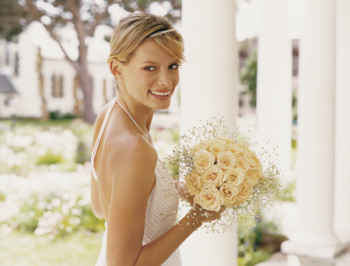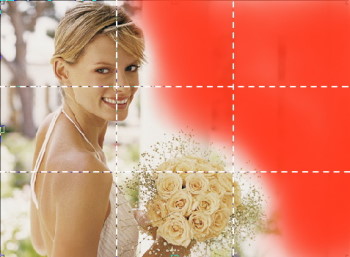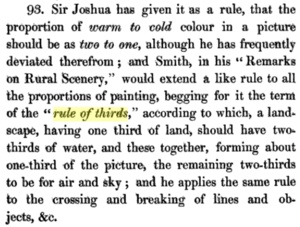摄影,既然要接触必然要跟着熟悉一下,摄影常识。其中之一就是“三等分定律”,指的是“构图”原则,是“原则”而不是“规定”,所以在从观景窗看出去时,不要拘泥于此。但对生手一开始还是先熟悉此一定律的运用,等熟悉了、摄影感觉够了再发挥。
三等分定律:想像你的相机观景窗被线条平均刻画成“垂直”及“水平”各三等分,等于是一个九宫格。将拍摄对象放在这些线条交会的其中一点上。他被应用在绘图与摄影上已经有相当久远的历史。原因很简单,因为他管用
我们的眼睛觉得如此的安排主题,既赏心悦目又具有活力。
譬如:你要为一位坐在咖啡厅的朋友拍照,假如你将她放在“画面正中央”位置,那么观者的眼光立刻就会投向她,观者只会稍稍留意一下你朋友周围的区域,因为观者了解摄影者除了拍摄对象外,对于其他东西比较不感兴趣。
然而,如果你将你朋友放在“画面中 1/3”位置,同样一个场景,观者的感觉却很不一样,会感受到更多咖啡厅蕴含的气氛,直觉了解到这是一幅人在咖啡厅的形象,不光只是人而已。
至于要把你的拍摄对象摆在那个交会点,取决于场景中还有些什么。要小心看,如果你的拍摄对象在“右边”,画面左边东西对影像有帮助或有害?如果看来不太满意,移动你的相机将她放在画面“左边”。
按照“三等分定律”要放在上面或下面交会点?如果她头上有个好看的天棚,就将她放在下面交会点,把天棚也纳进来。
记着:任何在观景窗中出现的东西都会出现在照片上,任何东西在那里都要有理由。
学习构图最有效的方法:研究画家或摄影家的作品,到博物馆或看书籍,当你感觉有那一幅影像打动你时,就去研究他,研究内容:
1. 为何喜欢?
2. 那位艺术家如何能产生这样的冲击?
3. 照相机在那里?
4. 是用多长的镜头?
5. 有多少景深
6. 光线带来什么样的感觉、从何而来?
7. 拍摄对象位置在那里?
8. 摄影家利用了那些前景要素、引导视觉的线条、图案、形状或纹理?


从网路上找到提及“三等分定律”的文章
人像构图上可以分成特写、半身、七分身、全身、带景等构图方式,依照当时模特儿的条件状况以及当时背景考量,可以做出很多变化,让你的影像有更多回味的空间。相对的,在拍摄当时请模特儿变换个角度表情或姿势,也可以增加很多许多幽默以及戏剧效果。
若拍摄风景照时,建议构图方式是将风景平面线(如地平面或海平面)切于 1/3 或 2/3 处以增加稳定感,试着把主体置于井字(也就是照片上下三等分,左右三等分)的交又点附近,这就称做运用黄金定律,将具有稳定作用及较佳视觉效果。
Rule of thirds
From Wikipedia, the free encyclopedia
The rule of thirds is a compositional rule of thumb in photography and other visual arts such as painting and design. The rule states that an image can be divided into nine equal parts by two equally-spaced horizontal lines and two equally-spaced vertical lines. The four points formed by the intersections of these lines can be used to align features in the photograph. Proponents of this technique claim that aligning a photograph with these points creates more tension, energy and interest in the photo than simply centering the feature would.
The photograph to the right demonstrates the application of the rule of thirds. The horizon sits at the horizontal line dividing the lower third of the photo from the upper two-thirds. The tree sits at the intersection of two lines, sometimes called a power point. Points of interest in the photo don’t have to actually touch one of these lines to take advantage of the rule of thirds. For example, the brightest part of the sky near the horizon where the sun recently set does not fall directly on one of the lines, but does fall near the intersection of two of the lines, close enough to take advantage of the rule.
The application of the rule of thirds to photographs is considered by many to make them more aesthetically pleasing and professional-looking. The rule of thirds can be applied by lining up subjects with the guiding lines, placing the horizon on the top or bottom line instead of the center, or allowing linear features in the photograph to flow from section to section. In addition, many photographers recommend treating any “rule” of composition as more of a guideline, since pleasing photographs can often be made while ignoring one or more such rules.

This photograph of a sunset taken in the Thousand Islands region demonstrates the principles of the rule of thirds
Utilizing
When photographing or filming people, it is common to line the body up with a vertical line, and having the person’s eyes in line with a horizontal one. If filming a moving subject, the same pattern is often followed, with the majority of the extra room being in front of the person (the way they are moving).
This works so that the subject is not surrounded by too much empty space.
History
The rule of thirds appears as early as 1797 as a rule for proportioning scenic paintings.

1845 reference to J T Smith’s illustrated book, published in 1797, defining a compositional “rule of thirds”






